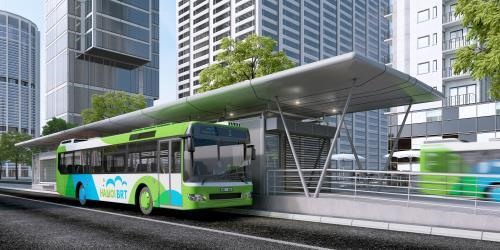 Society
Society

Hà Nội Transport Department will operate the first Bus Rapid Transit (BRT) pilot route from December 15, department deputy director Hà Huy Quang told local media yesterday.
 |
| The first BRT system in Hà Nội will run next month. — VNA/VNS Photo Thanh Tùng |
HÀ NỘI — Hà Nội Transport Department will operate the first Bus Rapid Transit (BRT) pilot route from December 15, department deputy director Hà Huy Quang told local media yesterday.
The BRT route, covering 14.7 km, will begin at the Kim Mã station in Ba Đình District up till the Yên Nghĩa station in Hà Đông District.
It will run through Giảng Võ, Láng Hạ, Lê Văn Lương and Lê Trọng Tấn, as well as Trần Phú and Ba La streets.
Some 21 bus stops have been built on the 14.7 km route, with a bus departing every five minutes and each carrying up to 90 passengers. Each bus is equipped with GPS system connected with a centre assisting in resolving incidents.
It will take an estimated 30 minutes to travel the entire route, as opposed to the current one hour or more.
The cost of the project is set at VNĐ1.1 trillion (US$53.6 million) and is being financed through World Bank loans.
Hà Nội Transport and Services Corporation (Transerco) has set up a BRT enterprise, which specialises in operating the bus route, Quang said, adding that the BRT route will be prioritised in terms of traffic lights and lanes. Cars and taxis are restricted from entering the priority lanes for BRT buses.
However, there are not separate lanes, only priority ones for BRT buses, therefore the bus model in Hà Nội is called “priority bus”, not “rapid bus” yet, he said.
Next month, the city will run four new bus routes: Nhổn-Tây Đằng, Yên Nghĩa-Phú Túc, Yên Nghĩa-Sơn Tây and Kim Mã-Nội Bài.
According to Quang, financial assistance from the city authorities for buses has decreased in recent years, from VNĐ1.078 trillion ($47.9million) in 2014 to a projected VNĐ957 billion ($42.5million) this year, presumably because of the oil and petrol price plunge.
In this context, the city has still made efforts to improve bus services and invested in bus infrastructure. Bus networks have been continuously expanded. Many suburban districts and new urban areas have access to buses, such as Quốc Oai District; Xuân Mai area; and Xa La, Văn Phú, Linh Đàm, Mỹ Đình, Tứ Hiệp and Kiến Hưng urban areas.
Nguyễn Công Nhật, Transerco deputy director, said the high-quality bus routes were put into operation with new buses, new bus colors and new employee uniforms. Free wifi is available on 15 routes with 200 buses. Until the second quarter of next year, the company plans to have free wifi on all operating routes.
Regarding plans for next year, municipal Transport Department’s deputy director Hà Huy Quang said in 2017, the public transport sector of the city will look to improving the passenger capacity and bettering service quality. Some 14 new routes will be added next year, increasing the total number of bus routes in the city to 115.
Priority lanes for buses will be studied on three routes -- Pháp Vân-Giải Phóng-Đại Cồ Việt intersection, Nguyễn Văn Cừ-Ngô Gia Tự and Phạm Hùng-Khuất Duy Tiến-Linh Đàm. — VNS